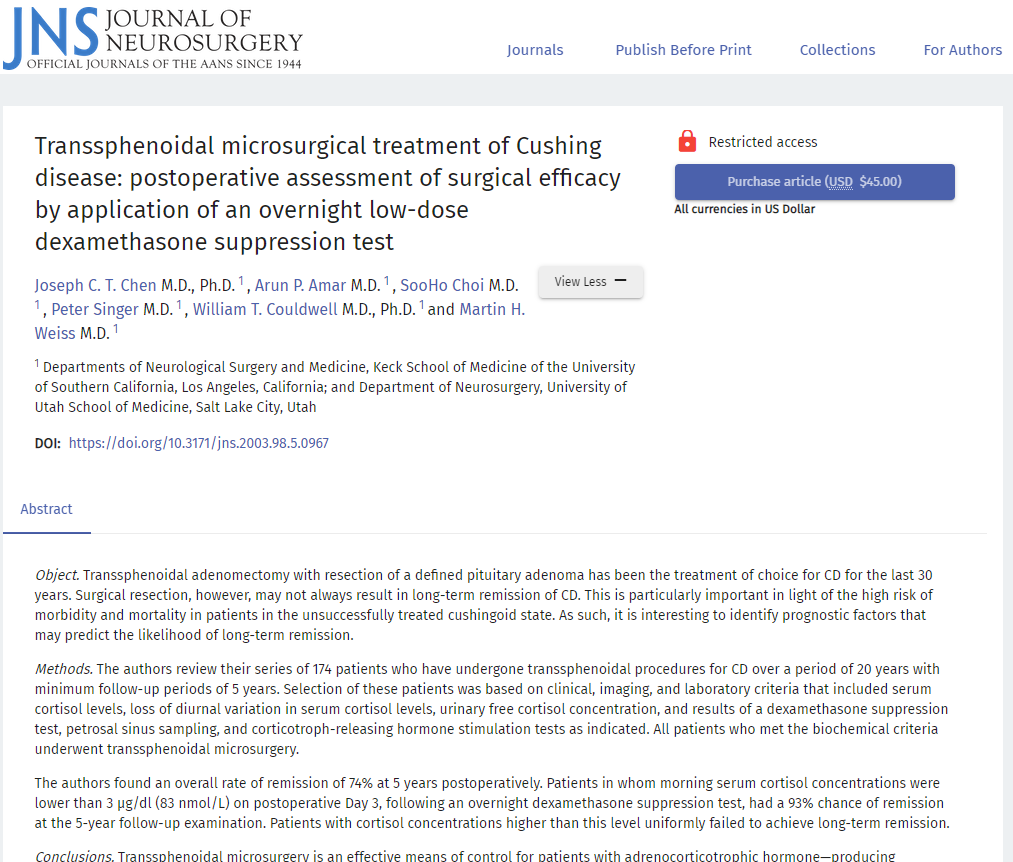经蝶窦显微外科治疗库欣病:术后应用低剂量地塞米松控制试验评估手术疗效(Transsphenoidal microsurgical treatment of Cushing disease: postoperative assessment of surgical efficacy by application of an overnight low-dose dexamethasone suppression test)
英文简介:
Object. Transsphenoidal adenomectomy with resection of a defined pituitary adenoma has been the treatment of choice for CD for the last 30 years. Surgical resection, however, may not always result in long-term remission of CD. This is particularly important in light of the high risk of morbidity and mortality in patients in the unsuccessfully treated cushingoid state. As such, it is interesting to identify prognostic factors that may predict the likelihood of long-term remission.
Methods. The authors review their series of 174 patients who have undergone transsphenoidal procedures for CD over a period of 20 years with minimum follow-up periods of 5 years. Selection of these patients was based on clinical, imaging, and laboratory criteria that included serum cortisol levels, loss of diurnal variation in serum cortisol levels, urinary free cortisol concentration, and results of a dexamethasone suppression test, petrosal sinus sampling, and corticotroph-releasing hormone stimulation tests as indicated. All patients who met the biochemical criteria underwent transsphenoidal microsurgery.
The authors found an overall rate of remission of 74% at 5 years postoperatively. Patients in whom morning serum cortisol concentrations were lower than 3 ?g/dl (83 nmol/L) on postoperative Day 3, following an overnight dexamethasone suppression test, had a 93% chance of remission at the 5-year follow-up examination. Patients with cortisol concentrations higher than this level uniformly failed to achieve long-term remission.
Conclusions. Transsphenoidal microsurgery is an effective means of control for patients with adrenocorticotrophic hormone-producing microadenomas. Clinical outcome correlated well with the size of the tumor, as measured on preoperative imaging studies, and with postoperative morning cortisol levels following an overnight dexamethasone suppression test. Postoperative cortisol levels can be used as a useful prognostic indicator of the likelihood of future recurrence following transsphenoidal adenomectomy in CD.
中文简介:
对象:在过去的30年里,经蝶腺瘤切除术和切除垂体腺瘤一直是治疗乳糜泻的优选方法。然而,手术切除并不能长期缓解乳糜泻。这一点重要,因为在治疗失败的库欣样状态下,患者的发病率和死亡率都很高。因此,确定可能评估长期缓解可能性的预后因素是很有趣的。
方法:作者回顾了他们的174例患者,这些患者在20年的时间里接受了蝶窦入路手术,较少随访5年。这些患者的选择基于临床、影像学和实验室标准,包括血清皮质醇水平、血清皮质醇水平昼夜变化的损失、尿游离皮质醇浓度,以及地塞米松控制试验、岩窦取样和皮质激素释放激素刺激试验的结果。全部符合生化指标的患者都进行了蝶窦显微手术。
作者发现术后5年总缓解率为74%。上午的病人血清皮质醇浓度低于3?g / dl (83 nmol / L)在术后三天,一夜地塞米松控制试验后,有93%的机会缓解5年随访检查。皮质醇浓度高于这一水平的患者均无法获得长期缓解。
结论:蝶窦显微手术是控制促肾上腺皮质激素微腺瘤的合适方法。临床结果与肿瘤的大小有很好的相关性,如术前影像学检查所测量的,与术后早晨地塞米松控制试验后的皮质醇水平有很好的相关性。术后皮质醇水平可作为一种有用的预后指标,以判断乳糜泻经蝶腺瘤切除术后复发的可能性。

该研究主要人员之一是INC国际神经外科医生集团旗下组织国际神经外科顾问团(WANG)成员William T. Couldwell教授。作为国际神经外科学院(WANS)主席、美国神经外科学院主席(2016年-2017年),William T. Couldwell教授发表了400篇同业评审的文章,著述了超过100本书籍章节、7本书籍,且多次获得了美国联邦与其他研究款项。他还是美国神经外科医师协会的全国际同行评审、电子出版物 Neurosurgical Focus 的主编,曾在多家期刊的编辑委员会任职,包括AANS神经外科医生、神经病学杂志、神经外科和精神病学、神经肿瘤学杂志和神经外科杂志。
资料来源:https://thejns.org/view/journals/j-neurosurg/98/5/article-p967.xml



